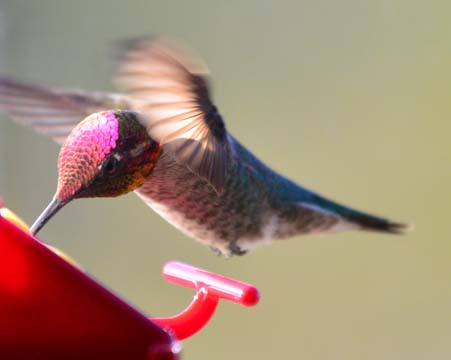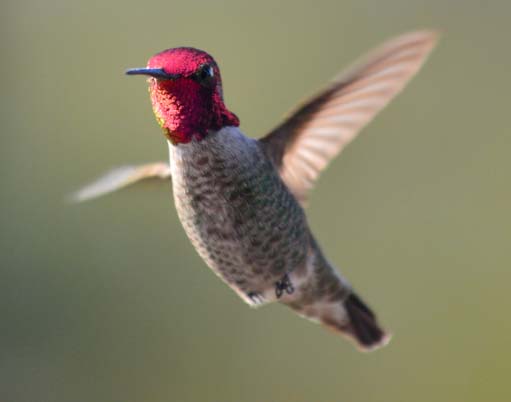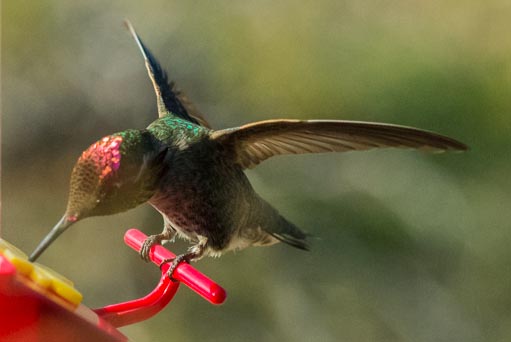
We love watching the hummingbirds come to our window feeder.
One of my favorite things to do when we set up camp is to put out our hummingbird feeder.

It’s hung with a suction cup – easy!
Hummingbirds always seem to recognize a feeder when they see one, and within a few hours of putting it out, we invariably have a tiny customer sitting on the perch drinking his fill.
There are lots of different kinds of hummingbird feeders on the market, but the one I like most for an RV mounts on the window with a suction cup.

A hummer visits our feeder at dawn

“Hello!”
We first saw one of these feeders when we spent a happy afternoon with our friends Bob and Donna Lea in their trailer during our first year of full-timing ages ago.
The hummers came by their feeder all afternoon, and the best part was that we could see them up close and at eye level while sitting comfortably on the couch.
This kind of feeder can also be a great way to get hummingbird photos, and the other day, while out in the Arizona desert, we decided to try our hand at being wildlife photographers from inside the comfort of our fifth wheel.

Swooping down for a drink
A simple concoction of 4 parts water to 1 part sugar (stirred up well to get the sugar to dissolve) is all it takes to lure the little guys to the feeder.
But the thing is, hummingbirds dart about erratically and move really fast.
Sometimes they hover for a while and look at you while they weave their wings back and forth in a figure eight pattern, as if they’re treading water. But then, suddenly, they turn and disappear in a flash.
Catching one on camera is not such an easy task!

He kindly hummed a little higher to give us a blue sky backdrop
Just as you get the bird in your viewfinder and have lined up the shot the way you want it and are ready to click the shutter — he’s gone.
Plus, the lighting can be tricky. Hummingbirds have irridescent feathers that light up like neon when the sun hits them in a certain way. But at other times their feathers look dull and dark.
Our feeder is often backlit by the sun, since we like to point our wall of windows to the south in the wintertime. This makes the hummers look like silhouettes, and frequently the lighting is such that their feathers don’t glow. at all

Hummingbird feathers appear dark when they aren’t lit up by the sun.
The way we have our trailer oriented right now, though, the hummer looked truly stunning at the feeder when we stood in one particular spot during the early afternoon.
The only hard part was that in this light the hummer had a pretty good view into the trailer from his perch, and our movements inside made him nervous. So, he wouldn’t stick around, especially when we were aiming a big black thing at him through the window.
To circumvent this, we set up a tripod at that spot with a remote shutter trigger.

Hovering
Our thinking was that we’d preset the focus to the perch area and then stand away from the window and click the shutter whenever the hummer turned up. A foolproof method, for sure.
The hummer made his appearance on queue and put on a great performance.
He hovered on the other side of the window, peered in at us, decided it was safe, sipped daintily while hovering, settled on the perch to drink a little more deeply, and then took off.
We happily clicked away on the shutter. How perfect!! These would be awesome photos!

Getting his balance on the perch…
But when we ran through the pics on the back of the camera, it was a disaster! Every single shot was hopelessly blurry.
Arghh! The 1/125 shutter speed was waaaay too slow.
So we set up at a faster speed, 1/2000, and waited. And waited and waited. We could see him flitting about in the trees, but he was being coy and wouldn’t come anywhere near the feeder.
Mark got bored and sat down to read a book. “That’s why I like landscape photography,” He said.
But I held out. For a while. I fidgeted. I yawned. And after a while I turned and opened the fridge, figuring I’d pass the time by munching on something.

He gives us a big wave!
Just as I got my hands on a snack, I heard Mark mutter, “Your little buddy’s back!”
Oh no! I dropped everything and dove for the camera remote.
I clicked it just in time to get a shot of the tip of the bird’s tail and his feet as he took off — and totally missed the wonderful images of him hovering just outside of the field of view of the camera.
Darn!
Well, one thing was clear. The tripod and the remote were awkward to maneuver and were too rigidly fixed to capture this speedy, darting bird.

The wings beat so very fast…
So I put the camera on a monopod with the idea that this time I’d be able to swing the camera around more freely and focus on him wherever he was rather than pre-focusing and hoping he hung out where the camera was focused. And then I waited, And waited and waited.
Mark chuckled at me over his book while I stood there. “Looks like you’ve got it all set up…” He said.
“Yeah. All I need is a bird!”
But the hummer was playing hard to get. My feet got tired. My knees got tired. I rested my chin on the camera and groaned. Where was that bird?

Those little wings keep them suspended and stationary in the air
Then he suddenly appeared, and I flew into action.
I’d chosen 3D focus tracking to try to keep the little guy in focus as he moved around. It was a mode someone had recommended online for bird photography.
As I pressed the shutter button partway down, little focus dots lit up all over the hummer while he was moving about.
It drove me crazy as it focused on his head, his feet, his tail, and his wings, constantly shifting from one part of his body to another.
It was totally distracting, and the result was random body parts being in focus. Ugh! This technique might work for some people, but it definitely wasn’t working for me!

The colors on his head and neck changed with every move he made.
I’d read that the best animal shots have the eyes in perfect focus. What good was it if the feathers on the bird’s round little belly were in focus but you couldn’t see his face clearly?
My little visitor disappeared again, and I was disappointed in my photos again.
Besides having great focus on everything but his face, in this group of pictures the dimming afternoon light mixed with the dimming afternoon light had made the ISO climb sky high, so the images were coming out rather grainy.
So it was back to the waiting game with a few more adjustments. “It will be another 10 or 15 minutes,” Mark said. “He got a really long drink that time!”

Another wave… I like this guy!
Man! I don’t know how wildlife photographers do it. Here I was in the comfort of my own home, yet I was impatient and bored and uncomfortable standing around waiting.
Imagine being holed up before dawn in some blind you’d built out in the wilds of Africa! Could any animal shot be worth that kind of effort?
Well, at least I had nothing else really pressing going on. We could hear the little hummber out in the branches of the trees making his funny little clicking noises.

While waiting for the hummer, I spotted a Gambel’s quail sauntering by.
Suddenly a Gambel’s quail caught my eye. He strutted past the window on a mission, his little top-knot feather bouncing up and down as he walked.
I love these little birds too, and I lifted the camera to my face, monopod and all, and stood on my tiptoes to get a shot of him running by.
Just then, the hummingbird was back at the feeder. And I was out of position!
Mark laughed out loud as I tried to get lined up and refocused while muttering something unintelligible under my breath.

Eating on the fly!
I jammed the shutter button down for a rapid-fire series of shots.
This time I’d nailed it. I knew it! And sure enough, when I looked at the photos a few minutes later the results were terrific and I was triumphant.
I gloated quite a bit as I showed a few of the images to Mark.
Now he was intrigued. I sat down, my own little mission accomplished, and watched him set up shop.

Picture perfect!

What a handsome little guy!
Ditching the monopod, he placed a tripod on the table and switched out the long 70-200 mm lens I had been using for a fixed length 85 mm.
He was bound and determined to make that remote shutter button work. I shook my head and said there was no way… but then, after a few attempts, he got some really spectacular shots!
Lately, our little bird friend has been hanging out with a buddy, and they seem to be taking our presence in stride.
I want to take this whole operation outside to get some images of them in the trees, and I had hoped to end this post with an awesome photo from the palo verde tree that’s just outside our trailer.
But our hummer and his friend have been keeping a low profile this afternoon. So, we’ll just have to wait and see if we can catch them tomorrow!
Love birds and animals? You might enjoy some of these other posts where we communed with animals during our travels:
- Sheep May Safely Graze (in the Mountains with Dogs!)
- Lost & Found – An Unexpected Guest Visits Us in our RV!
- The Day the Sheep Moved In!
- Fall Colors and Wildlife on the Sonoran Desert Rivers in Arizona
- Custer State Park Burros & Bison – Close Encounters of the Animal Kind
- Custer State Park Wildlife Loop Road – Where the Animals Are!
- Black Hills National Forest, SD, RV Boondocking – Camping with Cows!
- Eagles and Hummingbirds in Libby, Montana
- Arizona-Sonora Desert Museum – Wild Animals in Tucson AZ
- Peach Faced Lovebirds in Phoenix, AZ – Parrots in Cactus!
- Sandhill Cranes in Willcox Arizona – What a Party!
- Burrowing owls in Gilbert, Arizona – They’re a Hoot!
- Wild Horses of the Salt River in Phoenix
- Phoenix on the Wing – Waterbirds of Arizona!
- To Catch a Hummingbird (on camera!)
- On San Diego’s Shores – Dolphins and more!
- PV: Chamela to La Cruz – Dances with Whales at Cabo Corrientes
- Go Fish! – Some wild ways to catch dinner – It’s for the birds!!
- Huatulco’s Marina Chahué – Landlubbing with parrots!
- Loreto: Isla Coronado & Villa del Palmar – Taming the Sea of Cortez
- Best Friends Animal Sanctuary & Southwest Wildlife Foundation in Utah
